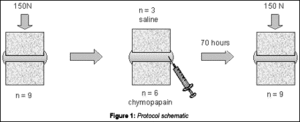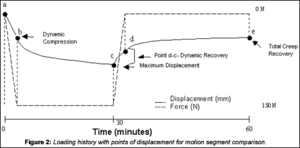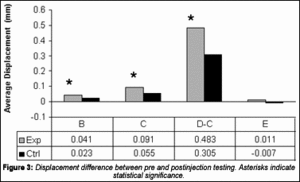Back pain? Blame the psoas. Seems as if everybody wants to dive headfirst into their psoas at the first sign of trouble with the lumbopelvic-hip region. Perhaps no other muscle is blamed more for causing problems than the psoas. Yes, it is an important stabilizer of the lumbar spine, but it shouldn't be the only one on which you focus. There is another big player on the scene: the iliacus.
The Effect of Nucleus Pulposus Digestion on the Mechanical Properties of the Bovine Intervertebral Disc during Static Compressive Loading: An Abstract
Background: Epidemiological studies indicate that 80 percent of the industrialized population will suffer from back pain at some point in their lifetime.1 Though the source of this back pain is largely unknown, the intervertebral disc (IVD) is often implicated as a primary or contributing factor. The majority of injuries to the IVD are thought to result from cumulative flexional and compressive loading,2 which, in turn, is thought to lead to disc dehydration, degeneration, and ultimately, dysfunction. To date, two studies have attempted to characterize this dysfunction through static loading of normal and denucleated discs in vitro.3,4 As denucleation is not a common initiator of disc injury in vivo, other mechanisms of experimental injury should be explored.

Objective: The objective of this study was to identify and compare biomechanical variables (dynamic stiffness and creep recovery) in normal and chemically digested bovine discs during compressive loading.
Methods: (specimen preparation): Fresh cadaveric bovine tails were obtained three hours postmortem. From these specimens, a total of nine motion segments were tested (six experimental, three control). Mechanical testing was conducted within three hours postdissection.
Mechanical Testing Procedure: Motion segments were potted in PMMA, and a materials testing device was used to apply a compressive axial load to each segment individually (150 N, ramp of 7.4 N/sec for 30 minutes). Following initial loading, intervertebral discs were injected in three marked sites with chymopapain (10mg/disc/0.1ml) or physiological saline (pH=6.23, 0.1ml/disc). All samples were incubated at 37¡ C for 70 hours, then loaded according to the previous protocol.

Analysis: A nonparametric test of significance (Wilcoxon signed ranks) was used to assess differences between pre and postinjection loading for experimental and control segments. A p value of 0.05 was assigned in advance to indicate statistical significance.
Results: The data collected during the static compression protocol resulted in a force-displacement curve, a representative of which is illustrated in Figure 2. With respect to dynamic compression (point b), the mean normalized displacement difference between pre and postinjection testing following the application of a 150-N force was 0.041 mm for the experimental segments and 0.023 mm for the saline controls. The average normalized displacement difference for maximal displacement (point c) and dynamic recovery (points d-e) for the chymopapain samples were 0.091 and 0.483 mm, respectively, while the saline controls measured displacements of 0.055 and 0.305 mm. Following zero-force application for a period of 30 minutes, the experimental samples recorded a pre/post-injection creep recovery displacement difference of 0.011 (point e) and the saline controls a displacement of -0.007 mm. Statistical significance was attained on all parameters (p=0.028), with the exception of total creep recovery for the experimental motion segments (p=0.600).

Conclusions: Chemical digestion of the nucleus pulposus of bovine tail motion segments alters the mechanical response of the intervertebral disc given the static compressive loading protocol used in this experiment. This method of initiating disc injury provides a useful blinding procedure for future studies that require test samples to be visually indistinguishable from control samples without the aid of advanced imaging. Such studies would be useful in the validation of new advanced imaging techniques capable of identifying early nuclear disc derangement for the purposes of clinical follow-up and postsurgical management.
References
- Kirkaldy-Willis WH, TN Bernard Jr. Managing Low Back Pain. Churchill Livingstone, Philadelphia, 1999.
- Jenson GM. Biomechanics of the lumbar intervertebral disk: a review. Physical Therapy 1980;60(6):765-773.
- Seroussi RE, MH Krag, DL Muller, MH Pope. Internal deformations of intact and denucleated human lumbar discs subjected to compression, flexion and extension loads. Journal of Orthopaedic Research 1989;7:122-131.
- Meakin JR, DWL Hukins. Effect of removing the nucleus pulposus on the deformation of the annulus fibrosus during compression of the intervertebral disc. Journal of Biomechanics 200;33:575-80.
Danielle Stewart-Smith,DC
Clinical Sciences resident, CMCC
Greg Kawchuk,BSc,DC,MSc,PhD,
University of Calgary



